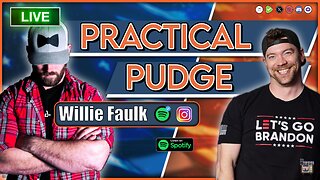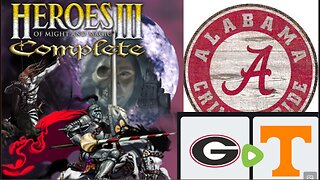Premium Only Content
![Blues Rhythm Guitar Lessons for Beginners [Easy Bass Line]](https://1a-1791.com/video/s8/1/j/c/7/h/jc7hc.qR4e-small-Blues-Rhythm-Guitar-Lessons.jpg)
Blues Rhythm Guitar Lessons for Beginners [Easy Bass Line]
This Blues Rhythm Guitar Lessons for Beginners video by Paluzzi Guitar will show how to play an easy bass line.
Lesson Plan /Guitar Tab https://12a8507c516b2ae55b6d45935a004...
Blues Guitar Lessons for Beginners Playlist
https://www.youtube.com/watch?v=OVNcy...
Blues Rhythm Guitar Lessons for Beginners [Easy Bass Line]
0:00 Lesson Preview
0:58 Lesson Intro
1:30 Steady Strumming Hand
2:13 Bars 1-4
3:13 Bars 5-8
3:54 Bars 1-8 (slow review)
4:40 Bars 9-12
6:48 Bars 9-12 (slow review)
7:59 Verse 1 (Bars 1-12 slow review)
9:07 Verse 2 Ending
10:00 Lesson Review
Easy Blues Bass Line Guitar Lesson for Beginners
For most beginners, learning to how to play a 12 bar blues rhythm on guitar will be challenging as it requires the ability to both strum and change chords while keeping tempo with a twelve-bar blues progression.
Easy Blues Bass Line Rhythm for Beginners
Before beginners attempt to strum a complete 12-bar blues shuffle rhythm, the first step will be to simply accompany a rhythm guitarist by playing an easy to learn twelve bar Blues bass line with single notes.
Blues Guitar Lessons for Beginners
Playing an easy 12-bar bass line while following a twelve-bar blues rhythm guitar progression will help develop a sense of timing, which in turn will help beginners with eventually strumming twelve-bar blues rhythm progressions unaccompanied.
Play Easy Bass Line along with Blues Rhythm Guitar in 12 Bar Progression
This 12-bar beginner blues bass line can be played along with a twelve-bar Blues shuffle progression in the Key of ‘A’. Count each bar of this 12-bar blues progression as ‘one-two-three-four...one-two-three-four.’ At Bar 12 of this 12-bar blues rhythm progression, be sure to emphasize the first two-beats, then play either the turnaround to repeat the 12-bar progression, or play the ending to finish the twelve-bar progression.
Paluzzi Guitar
The objective of the Paluzzi Guitar video series is to help establish a foundation of guitar fundamentals by applying various playing techniques (rhythm, fingerstyle, and soloing) to various styles of music. The more playing styles and techniques a guitarist can learn, the more diverse and self-sufficient a guitarist will become. A self-sufficient guitarist can then teach themselves, communicate with other musicians, and even write their own music once a solid foundation of fundamentals is established.
The Creative Guitarist Method Series was written and designed by Kevin J. Paluzzi of Paluzzi Guitar Instruction in San Diego, CA. For more information on private lessons and books, go to:
There really isn’t any one particular playing style or technique required in order to classify someone as a guitarist. For example, Andres Segovia, the Beatles, and Carlos Santana are all considered legendary performing guitarists, but each has his own particular style or technique (fingerstyle, strumming, and soloing) for playing. Every guitarist will have their own personal preferences when it comes to what style of music they would initially like to learn. Some may have a more-specific goal (singer/songwriter, soloist, etc.), while others may prefer a more general or overall approach to learning various playing styles and techniques. This series of books and videos are designed with a ‘pick and choose’ topic format (songwriting, soloing, etc.) so that once the Guitar Basics are completed, the guitarist can decide to focus on whatever topic they wish to study.
-
![Blues Rhythm Guitar Lessons for Beginners [12 Bar Texas-Style]](https://1a-1791.com/video/s8/1/9/u/8/h/9u8hc.0kob-small-Blues-Rhythm-Guitar-Lessons.jpg) 10:50
10:50
PaluzziGuitar
3 years agoBlues Rhythm Guitar Lessons for Beginners [12 Bar Texas-Style]
459 -
![Blues Rhythm Guitar Lessons for Beginners [12 Bar Texas-Style]](https://1a-1791.com/video/s8/1/a/G/9/h/aG9hc.0kob-small-Blues-Rhythm-Guitar-Lessons.jpg) 12:37
12:37
PaluzziGuitar
3 years agoBlues Rhythm Guitar Lessons for Beginners [12 Bar Texas-Style]
4614 -
![Blues Rhythm Guitar Lessons for Beginners [12 Bar A Shuffle]](https://1a-1791.com/video/s8/1/I/7/7/h/I77hc.0kob-small-Blues-Rhythm-Guitar-Lessons.jpg) 10:22
10:22
PaluzziGuitar
3 years agoBlues Rhythm Guitar Lessons for Beginners [12 Bar A Shuffle]
456 -
![Blues Soloing Guitar Lessons for Beginners [Open E Riffs]](https://1a-1791.com/video/s8/1/n/P/2/h/nP2hc.0kob-small-Blues-Soloing-Guitar-Lesson.jpg) 6:42
6:42
PaluzziGuitar
3 years agoBlues Soloing Guitar Lessons for Beginners [Open E Riffs]
674 -
![Blues Guitar Lessons for Beginners [How to Play E Shuffle Rhythm]](https://1a-1791.com/video/s8/1/D/_/X/g/D_Xgc.0kob-small-Blues-Guitar-Lessons-for-Be.jpg) 8:10
8:10
PaluzziGuitar
3 years agoBlues Guitar Lessons for Beginners [How to Play E Shuffle Rhythm]
618 -
 2:50:48
2:50:48
PudgeTV
21 hours ago🟡 Practical Pudge Ep 48 with "Willie Faulk" | Catching Up With Old Friends
81.4K3 -
 18:32
18:32
Forrest Galante
1 day ago5 Extinct Animals That I Believe Could Still Be Alive...
183K39 -
 DVR
DVR
Major League Fishing
3 days agoLIVE! - General Tire Team Series: Summit Cup - Day 1
169K7 -
 7:05:23
7:05:23
Hevel Gaming
1 day ago $70.20 earnedNCAAF Tennessee at Georgia While with Heroes of Might and Magic III & Helldivers 2
263K26 -
 6:34:08
6:34:08
MissesMaam
1 day agoI'm Addicted | Sons of the Forest 💚✨
199K32